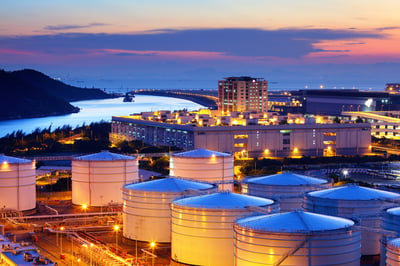 Oil and gas companies have increasingly faced the twin challenges of low prices and increased competition from renewables. The COVID-19 pandemic has made the situation much more difficult. For example, the US benchmark for the price per barrel of crude dropped from $63 in January 2020 to below zero in April 2020. In the second quarter of 2020, 18 producers filed for bankruptcy; that's the second-highest quarterly increase in the last five years.
Oil and gas companies have increasingly faced the twin challenges of low prices and increased competition from renewables. The COVID-19 pandemic has made the situation much more difficult. For example, the US benchmark for the price per barrel of crude dropped from $63 in January 2020 to below zero in April 2020. In the second quarter of 2020, 18 producers filed for bankruptcy; that's the second-highest quarterly increase in the last five years.
Controlling costs and optimizing supply chain processes and production systems are not nice to have for oil and gas companies; they are necessary for survival. That's why more leaders in the sector wondering how to improve the oil and gas industry are turning to the practices that manufacturing companies have long used to reduce waste, improve quality, and speed projects to completion. It all starts with the simple idea that every process can be improved and that continuous improvement is the employee's responsibility.
The Benefits of Continuous Improvement for Oil and Gas Companies
The need for the moment is to overcome challenges faced in the past regarding productivity and performance improvement. The current landscape has made it essential to manage projects in them as efficiently as possible to safeguard margins. Companies should seek to develop a strategy for performance improvement that will help reduce costs and equate to higher margins in the following ways:
Improved Sustainability
Here we are not just referring to sustainability in the environmental sense, which can be improved using continuous improvement practices and a business sense. Lowering cost, reducing waste, and enhancing customer relations create a future that is easier to project. Standardizing processes makes an organization more resilient and better able to absorb new stressors.
Employee Satisfaction and Engagement
Continuous improvement has the impact of increasing employee satisfaction due to clear expectations, productive projects, and fully utilized skills. Efficient workspaces, the ability to do one's best work, and tools to support improvement all result in better morale. Employees who are trained in continuous improvement techniques frequently offer innovative solutions to complex problems.
Product Quality
One goal of continuous improvement is to reduce variation in the product and deliver a higher-quality product to customers. This is especially essential in commodities markets such as oil and gas where innovation is related to business processes rather than product enhancements.
Higher Margins
Improved margins are the top goal for many in the oil and gas industry. Continuous improvement can address opportunities related to equipment startups, maintenance, and checkouts on the floor. It can also be applied to larger projects such as extraction and capital projects.
8 Ways the Oil and Gas Industry is Making Better Use of Sustainable Technologies
Because oil and gas companies produce so much of global energy, they have a special responsibility to implement solutions that deliver clean energy and promote energy efficiency.
- 3D modeling and advanced robotics: Using technology to assess the viability of dig sites and structural integrity of existing wells reduces waste and helps control the carbon footprint.
- Investing in and implementing renewable energy: Renewable energy, particularly solar energy, has a vital role to play in making the production of fossil fuels more environmentally friendly.
- Reducing carbon emissions: Oil and gas companies are working to reduce their own carbon emissions. A spokesperson for Chevron told CNN that the company even supports a carbon emission tax.
- Recycling: One current innovation involves recycling used oil to convert it into diesel fuel, which enables energy companies to produce two products from the same drilled ore.
- Environmental management systems: These programs center on planning for the impact on the environment from oil and gas development, including the potential effects on the soil, water, and entire ecosystem of the area in which oil and gas exploration and drilling occur.
- Decreasing freshwater usage: To decrease freshwater usage, oil & gas companies are exploring more effective ways of recycling and reusing water for their operations by improving filtration oxidation methods and advanced chemical-free water treatment solutions.
- Data analysis: Data analytics technology and expertise can overcome the operational complexity of oil and gas operations, quickly improving productivity and reducing environmental impact by reducing waste, accidents, and bottlenecks.
- General process improvement: Even if a particular improvement doesn't have a direct environmental impact, improved processes that increase efficiency have an indirect impact on making the organization greener.
The Keys to Success
Many oil and gas organizations find it challenging to implement the continuous improvement approach because it requires a cultural transformation, and some people find new ways of working overwhelmingly. Our clients who have successfully navigated the shift have found several factors to be essential.
Leadership
While the goal is to get every employee thinking about improving the processes they operate every day, it starts with the top. Employees must internalize that continuous improvement is not a management fad or the plan for today but rather the key to survival. Leaders must demonstrate trust, humility, and a willingness to invest in what it takes for positive change.
Technology
Leaders in oil and gas know that the best way to reduce variation in processes is to automate them to the extent possible. You can't automate continuous improvement because it is a fundamentally people-centric idea, but you can support it with technology.
Impact Analysis
A further advantage of continuous improvement software is that it aids in achieving the final ingredient for success, impact measurement. The best way to get employees and management excited about the potential of continuous improvement is to demonstrate results in terms of quality improvement, cost reduction, project speed, environmental impact, regulatory compliance, and customer satisfaction.
The time is now for oil and gas companies to innovate themselves and revamp the way they carry out everything from daily operations to E&P and capital construction projects. Opportunities to improve exist all along the way, and companies that seize them will win the market of the future.
![[Watch Now] The Why, How, and What of Continuous Improvement](https://no-cache.hubspot.com/cta/default/326641/060c8cc9-44ad-4fd1-ad7b-7b4ab71c7632.png)



Add a Comment